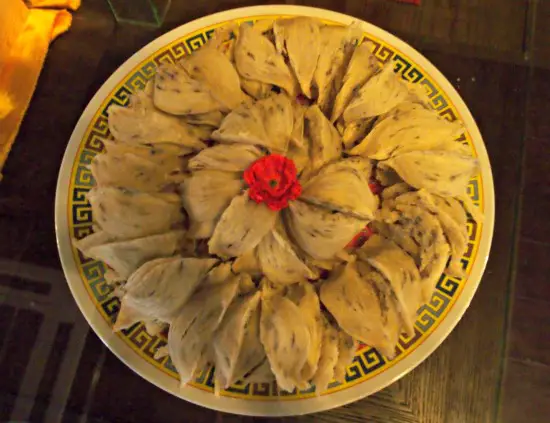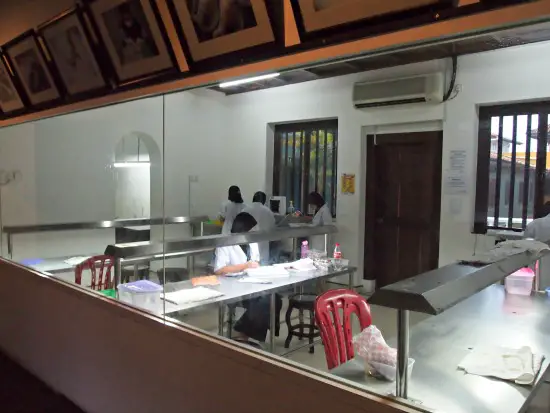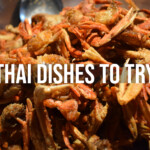This post may contain affiliate links.
The mere mention of birds’ nest soup conjures up images of a really strange concoction. Most have never tried it and a large number of people don’t even know someone that has. Yet the Chinese first started using swallow nests for soup over 1500 years ago.
Birds’ nest soup is a delicacy in traditional Chinese cuisine and can be found in parts of Southeast Asia with a Chinese influence or population.

Malacca, being on the old trade routes, and Malaysia as a whole, has an extremely diverse culture. Chinese influences are really obvious in religion, architecture, cuisine, and population. Birds’ nest soup, made from the nests of a tiny edible bird, is one such example. We went to investigate a swiftlet nesting house and edible bird nest production facility in Malacca, Malaysia.

We took a guided tour to see the little swiftlets nesting and learn about the processes involved in gathering and cleaning the swiftlet nests from the cave wall to the pot. This post mostly contains information given to us by our guide in Malacca.
The saliva the swallows use to make the soup has a very high protein content, it’s not just digestive secretions, it has nutrient value.

Birds Nest Soup Malacca
In Malacca, Malaysia, I didn’t think I would stumble over any birds nest soup shops let alone a breeding ground for it. In the old Chinese quarter, only one street back from Jonker street and overlooking our hostel we found an old house turned into both a breeding area for swiftlets, and museum.
History of Birds Nest Soup
The first bird’s nest soup actually came from the Southern Asian countries, where most are still produced, and brought back by sea traders to the Emperors of the Tang dynasty. During the Tang reign, the royal family and their guests alone could sample it. After the Tang dynasty, it became popular among the Chinese because of its perceived nutritional properties and rarity.
Modern day demand is now spread across the world with Hong Kong and mainland China being the biggest importers of nests. Taiwan, Singapore, USA and the Middle East are also big importers, feeding the huge expat Chinese communities more than local people.
Two types of edible nests are used, white is more common and red is rarer, and much more expensive. Both are made from bird saliva. Birds’ nest soup joins a long list of weird foods that people are able to experience more and more often, thanks to travel.
What is Birds Nest Soup?
Birds nest soup involves using dried and cleaned birds’ nests to make a soup. The type of bird and nest are extremely important in making the soup. All of the soups have a gelatinous texture and apparently are very nutritious.
Swiftlets and swallows are the most common types of birds used to make the nests. Both the red and white nests have the most nutritional value according to Chinese birds’ nest soup makers. Because of this they are the most sort after and cost the most to purchase.
Surprisingly the taste is predominately of the ocean. As the birds live and feed near the ocean and the nest is mainly produced from their saliva, spewdom, and droppings. It is also quite salty due to the connection with the ocean.
Besides this, the taste is quite bland in comparison to other Chinese dishes that most people will try. Eating this soup is probably more of a status thing than an actual health benefit.
Bird nest soup is very simple and can be made with just hot water, sugar (rock sugar) and ginseng or goji berries. Find a birds’ nest soup recipe here.
How Much Does a Bowl of Bird Nest Soup Cost?

It is the most expensive food eaten by people today. We were told that a bowl in a top restaurant in Hong Kong will sell for upwards of $40 for white and $100 US for a red soup. If you wanted to buy the raw nests to take home for Chinese cooking, they ranged from $2000 per kilo for the white to $10,000 for the red nests. Due to the cost, it is a food reserved for special occasions. Chinese New Year is the busiest time of the year for sales of the soup and the nests.
The rarity and the difficulty in harvesting the nests is one reason they are so expensive. The swallows almost always nest in very high rocky outcrops hundreds of feet in the air. Many harvesters die each year in pursuit of these nests. Using rickety wooden ladders hundreds of feet in the air there is no margin for error.
These days, across Southeast Asia, you will find nesting houses converted for use by the birds, to make harvesting easier. You will often hear loudspeakers blasting out swiftlet calls, presumably to attract the birds, we’ve seen these in Borneo and Vietnam.
Malacca’s Birds Nest Soup Shop
Head deep enough into Chinatown and you will find birds nests for sale. What made the Malacca shop so unique was that the front and some upper areas of the small house contained dark cave-like areas to actually harvest the birds’ nests.
We were shown the building and the nest processing by the curator of the museum who explained everything in great detail. We had flashlights to see the birds flying around and making their nests. Harvesting them here wasn’t hazardous, the building was only two stories high.
As a chef, to see the process from start to finish was amazing and a unique experience that I loved. With the comprehensive talk from the curator, we glimpsed a world that few would see. Thailand is now the biggest producer of red birds nests with a limestone cave on a birds nest concession island. Borneo and Indonesia are the big harvesters of white nests.
Like the Malacca shop, there has been a push to convert deserted shop houses into breeding grounds for the swallows across Asia. Poured and plastered with concrete to mimic the natural caves the birds prefer, it has allowed people to increase supply. Prices haven’t dropped as it is still vastly undersupplied industry with huge demand from the Chinese inside and outside China.

Our guide showed us a little trick to make sure the red bird nest was really red, not a dyed white. With nearly $8,000 difference you would want to be sure. You also need to make sure your pure white bird’s nest hasn’t been bleached, genuine white nests are a yellowish colour.
Recently with the demand, China actually stopped importing Malaysian birds nest due to counterfeit nests on the market. The Malaysian government has now employed RFID technology to combat this problem and therefor try to resume exports to China.
UPDATE: In December of 2017 China lifted its import ban on Malaysian birds nests which has seen a marked increase in the price of the Malaysian nests. As China’s middle class increases and the disposable income increases I can only see an increase in demand which will out strip supply for quite a few years to come.
Have you ever tried bird nest soup?
If you'd like to hire a car during your stay, use this car rental comparison tool to find the best deal!
Please check out our Pinterest account for loads of food and recipes from around the world!










I’ve been looking at it quite often, when in Malaysia and Singapore – but the price has always stopped me from trying. (low-budget travelling….) What would you say it tastes like?
Then again, as I don’t really know what to expect, I’d be afraid to be ripped off. I think I’d only try it if accompanied by somebody local who knows what to look for!
Thanks for reading Talitha, We know all about the low budget traveling. As a family of four it isn’t easy balancing travel and spending. Truth be told it isn’t a massive taste sensation. The nutritional value is great but compared to all the other Asian foods to try this is a long way down my list of foods. As long as you buy from a reputable establishment that can show/track where the nest came from you should be fine. Expect to pay big $$. If it is cheap then be suspicious. I would advise tasting it in a reputable restaurant that already has the reputation for it. Either way bring serious cash for what is, in essence a soup for $50plus. Hope that helps. James
I haven’t tried birds nest soup and it doesn’t sound all that appetising to me either, especially considering how much it costs! It sounds like an interesting process though; we considered visiting one of those caves while we were in Malaysian Borneo but didn’t have time in the end.
Thanks Amy, Yes it certainly is interesting seeing the birds and their nests. It isn’t a taste sensation. Your not missing much to be honest. That reminds me we need to go to Malaysian Borneo. Cheers James